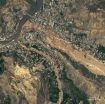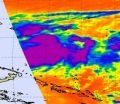(Press-News.org) A NASA study using TRMM satellite data revealed that the year 2010 was a particularly bad year for landslides around the world.
A recent NASA study published in the October issue of the Journal of Hydrometeorology compared satellite rain data from NASA's Tropical Rainfall Measurement Mission (TRMM) to landslides in central eastern China, Central America and the Himalayan Arc, three regions with diverse climates and topography where rainfall-triggered landslides are frequent and destructive hazards to the local populations.
The work, led by Dalia Kirschbaum, a research physical scientist in the Hydrological Sciences Laboratory at NASA's Goddard Space Flight Center in Greenbelt, Md., is part of an ongoing effort to catalog worldwide rainfall-triggered landslides—one of the world's lesser known but often catastrophic natural hazards. Locating them is a step in an effort to be able, one day, to predict and warn.
Currently, Kirschbaum explains, no consistent regional or global scale warning system exists for landslide disasters. To create one, scientists need to understand more than the individual factors that may contribute to local landslides -- the intensity and total amount of rainfall over hours to days, slope angle, soil type and saturation, among others.
"For other hazards like hurricanes, there's a clearly defined season," says Kirschbaum. "From satellite data and observations we know that hurricane season in the Atlantic spans from June 1 to Nov. 30. But we don't have that type of record for landslides around the world, and we want to know when and where to expect them in different regions."
Scientists also need a systematic way to assess landslide hazards for a region, and one way to do that, says Kirschbaum, is to look at the distribution and intensity of rain from satellite data and see how that correlates with where and how often landslides are being reported.
Creating Science by the Slice (of News)
The first step to developing landslide hazard assessments is to improve record keeping, Kirschbaum says. For the past several years, she has been developing the first global database for landslides triggered by rain, called the Global Landslide Catalog (GLC). Landslides are often too small to pick out of satellite imagery, so news stories are currently the best sources of information.
Daily, she and other research assistants examined media reports for possible landslides and dug out details such as where the landslide occurred, whether the landslide was triggered by a rain shower or a tropical cyclone, if there were fatalities, and if the type of landslide was characterized as a mudslide or a debris flow, among other characteristics. The GLC now has six complete years of data—2003, and 2007 through 2011—with new entries continually added. It contains more than 4,000 events that describe 20,600 reported fatalities among 60 different countries for 2007 through 2011.
However, Kirschbaum notes, landslide events are not uniformly reported around the world, with some not making the news unless they cause deaths or property damage. After compiling the 2010 record, Kirschbaum noted that 2010 appeared to be a particularly devastating year for landslides in parts of China, Central America and the Himalayan Arc. Kirschbaum compared the GLC with satellite-based rainfall information from TRMM and other satellites to see if the higher numbers of landslide reports corresponded with a higher amount of rainfall for those areas.
Fact-Checking the Stories with Impartial Witnesses
The TRMM Multisatellite Precipitation Analysis (TMPA) data includes rain data from 50 degrees north latitude to 50 degrees south latitude – from southern Canada to the tip of South America--providing three-hourly and daily coverage of precipitation. Kirschbaum and her team relied on TMPA's 14-year record to provide a picture of global rainfall that could be related to landslides that occurred.
The big advantage of TMPA data, compared to ground data such as that from rain gauges, is that it measures rainfall in the same, consistent way over large regions. This provides a broader perspective that helps researchers like Kirschbaum and eventually forecasters equipped with satellite rainfall data to detect the kinds of rainfall signatures that are likely to produce destructive landslides.
Stating that extreme or prolonged rainfall can lead to landslides is not anything new, Kirschbaum says, but what is novel is that by examining the Global Landslide Catalog and TMPA precipitation record together, she can look at how reported landslide events compare with rainfall amounts. This in turn helps her find areas where landslides may be occurring but are not being reported.
Revealing the Long, Data-Drawn Truth
2010 was indeed an extraordinary year for landslides, says Kirschbaum, with three times as many reported events and twice as many reported fatal events as previous years within the Global Landslide Catalog.
Zhouqu County, China, was hit by the deadliest landslides in decades, according to state media, which buried some areas under as much as 23 feet (7 meters) of suffocating sludge. 1,765 people died. Property damages totaled an estimated $759 million. The TMPA rain data showed that the region's susceptible, steeply sloped geography was pummeled by extreme rainfall from a local cloudburst.
"This is really the first time that you can see how rainfall varies with respect to rainfall-triggered landslides because no other database has this type of globally consistent view," says Kirschbaum.
While most of the intense rainfall that triggers landslides is local in scale, global atmospheric circulation patterns can often affect these local conditions. As Kirschbaum explains: "What I think is unique about 2010 is there is a really strong El Niño going into a really strong La Niña, which consequently impacted rainfall patterns around the world."
Eventually, as the database of both landslides and rainfall data grows, Kirschbaum will be able to see more defined patterns in landslide occurrence month-by-month, and if those patterns are changing.
"I think in some ways we can compare the situation with landslides with that of earthquakes 50 years ago," says David Petley, professor and co-director of the Institute of Hazard, Risk and Resilience at Durham University's Department of Geography. "Our understanding of earthquakes improved dramatically when a global seismic array was deployed that allowed us to map earthquakes in space and time, providing insight into plate tectonics and thus earthquake mechanisms. We have not been able to map landslides in the same way, which means that we lack that time and space understanding. Dalia's work is important because she is collating this data, which is providing new insights."
Until there's enough data about where and when landslides have occurred in the past, there will not be enough information to issue useful warnings about future events at the global scale. Kirschbaum plans to expand the Global Landslide Catalog in order to provide a more complete dataset to evaluate landslide forecasting models. Adequate warning, one day, could help vulnerable people escape roaring slurries of slumping earth, to recover, rebuild or relocate.
This work was funded by the upcoming Global Precipitation Measurement (GPM) mission, which will improve upon current rainfall datasets, with real-time assessment of rainfall accumulations that lead to landslide triggering. The GPM Core satellite is set to launch in 2014 and will extend coverage of precipitation measurements using a constellation of satellites to deliver a global rain dataset every three hours.
INFORMATION:
For more information about the GPM mission, visit:
http://www.nasa.gov/gpm
For more information about NASA's TRMM satellite, visit:
http://trmm.gsfc.nasa.gov
NASA's TRMM satellite confirms 2010 landslides
2012-11-28
ELSE PRESS RELEASES FROM THIS DATE:
Fast forward to the past: NASA technologists test 'game-changing' data-processing technology
2012-11-28
It's a digital world. Or is it?
NASA technologist Jonathan Pellish isn't convinced. In fact, he believes a computing technology of yesteryear could potentially revolutionize everything from autonomous rendezvous and docking to remotely correcting wavefront errors on large, deployable space telescope mirrors like those to fly on the James Webb Space Telescope.
"It's fast forward to the past," Pellish said, referring to an emerging processing technology developed by a Cambridge, Mass.-based company, Analog Devices Lyric Labs.
So convinced is he of its potential, Pellish ...
NASA sees Tropical Storm Bopha intensifying in Micronesia
2012-11-28
Tropical storm warnings are in effect in Micronesia as NASA and other satellite imagery indicates that Tropical Storm Bopha continues to intensify.
The Atmospheric Infrared Sounder (AIRS) instrument that flies aboard NASA's Aqua satellite captured an infrared image of Tropical Storm Bopha on Nov. 27 at 0241 UTC that indicated a lot of power exists in the strengthening tropical storm. The AIRS image captured the eastern half of the tropical storm and showed a large area of very cold, very high cloud tops, where temperatures colder than -63 Fahrenheit (-52 Celsius) have ...
High altitude climbers at risk for brain bleeds
2012-11-28
CHICAGO – New magnetic resonance imaging (MRI) research shows that mountain climbers who experience a certain type of high altitude sickness have traces of bleeding in the brain years after the initial incident, according to a study presented today at the annual meeting of the Radiological Society of North America (RSNA).
High altitude cerebral edema (HACE) is a severe and often fatal condition that can affect mountain climbers, hikers, skiers and travelers at high altitudes—typically above 7,000 feet, or 2,300 meters.
HACE results from swelling of brain tissue due ...
Most patients in the dark about what radiologists do
2012-11-28
CHICAGO – The role of radiologists in healthcare has long been poorly understood among the general public, but new research presented today at the annual meeting of the Radiological Society of North America (RSNA) shows that even patients who've had imaging exams in the past know little about the profession.
Researchers said the study findings highlight an opportunity for radiologists to educate the public about their role in healthcare.
"We know from previous studies that about half of the general public doesn't even know that radiologists are physicians," said Peter ...
Men with belly fat at risk for osteoporosis
2012-11-28
CHICAGO – Visceral, or deep belly, obesity is a risk factor for bone loss and decreased bone strength in men, according to a study presented today at the annual meeting of the Radiological Society of North America (RSNA).
"It is important for men to be aware that excess belly fat is not only a risk factor for heart disease and diabetes, it is also a risk factor for bone loss," said Miriam Bredella, M.D., radiologist at Massachusetts General Hospital and associate professor of radiology at Harvard Medical School in Boston.
According to the National Center for Health ...
CT depicts racial differences in coronary artery disease
2012-11-28
CHICAGO – While obesity is considered a cardiovascular risk factor, a study presented today at the annual meeting of the Radiological Society of North America (RSNA) showed that African-American patients with coronary artery disease (CAD) have much less fat around their hearts compared to Caucasian patients.
"Prior evidence suggests that increased fat around the heart may be either an independent marker of CAD burden or a predictor of the future risk of acute coronary events," said U. Joseph Schoepf, M.D., professor of radiology and medicine and director of cardiovascular ...
New study: Many flame retardants in house dust -- unsafe levels
2012-11-28
A peer-reviewed study of the largest number of flame retardants ever tested in homes found that most houses had levels of at least one flame retardant that exceeded a federal health guideline. The journal Environmental Science & Technology will publish the study online on November 28, 12:01am Eastern.
The study led by scientists at Silent Spring Institute tested for 49 flame retardant chemicals in household dust, the main route of exposure for people and especially for children. Forty-four flame retardant chemicals were detected and 36 were found in at least 50% of the ...
Complications challenge rheumatoid arthritis patients after joint replacement surgery
2012-11-28
In the first systemic review of evidence assessing complications following total joint arthroplasty, patients with rheumatoid arthritis (RA) were found to have an increased risk for hip dislocation after hip replacement surgery compared to those with osteoarthritis (OA). Study findings published online in Arthritis & Rheumatism, a journal of the American College of Rheumatology (ACR), also indicate that RA patients have a higher infection risk following total knee replacement than patients with OA.
The ACR reports that OA—the most common form of arthritis—affects 27 ...
Printing soil science
2012-11-28
Imagine printing a 3-D object as easily as a typed document. Lose a button? Print one. Need a new coffee cup? Print one. While the reality of printing any object on demand may lie in the future, the technology necessary to do it has been available for decades. And soil scientists are now taking advantage of its possibilities.
In a paper published online this week in the Soil Science Society of America Journal, a team of researchers headed by Philippe Baveye explored the potential of manufacturing soil science equipment using 3-D printing. They found that the technology, ...
NREL researchers use imaging technologies to solve puzzle of plant architecture
2012-11-28
Scientists at the U.S. Department of Energy's National Renewable Energy Laboratory (NREL) and the BioEnergy Science Center (BESC) combined different microscopic imaging methods to gain a greater understanding of the relationships between biomass cell wall structure and enzyme digestibility, a breakthrough that could lead to optimizing sugar yields and lowering the costs of making biofuels.
A paper on the breakthrough, "How Does Plant Cell Wall Nanoscale Architecture Correlate with Enzymatic Digestibility?" appears in the current issue of Science Magazine.
Principal ...


